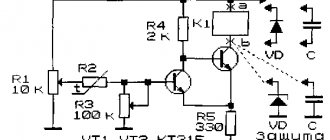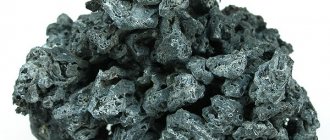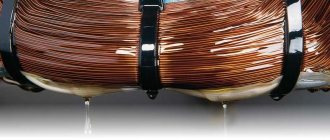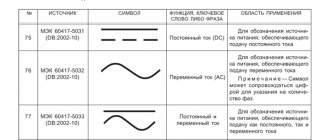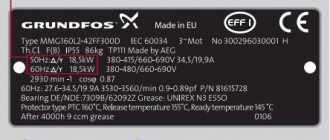Basic information and brands of nichrome
Nichrome is an alloy of nickel and chromium with additions of manganese, silicon, iron, and aluminum. The parameters of this material depend on the specific ratio of substances in the alloy, but on average they lie within the limits:
- specific electrical resistance - 1.05-1.4 Ohm*mm 2 /m (depending on the brand of alloy);
- temperature coefficient of resistance - (0.1-0.25)·10 −3 K −1;
- operating temperature - 1100 °C;
- melting point - 1400°C;
In tables, resistivity is often given in µOhm*m (or 10 -6 Ohm*m) - the numerical values are the same, the difference is in dimension.
Currently, there are two most common brands of nichrome wire:
- Х20Н80. It consists of 74% nickel and 23% chromium, as well as 1% each of iron, silicon and manganese. Conductors of this brand can be used at temperatures up to 1250 ᵒ C, the melting point is 1400 ᵒ C. It is also characterized by increased electrical resistance. The alloy is used for the manufacture of elements of heating devices. Specific resistance – 1.03-1.18 µOhm m;
- Х15Н60. Composition: 60% nickel, 25% iron, 15% chromium. Operating temperature is no more than 1150 ᵒ C. Melting point – 1390 ᵒ C. Contains more iron, which increases the magnetic properties of the alloy and increases its anti-corrosion resistance.
You will learn more about the grades and properties of these alloys from GOST 10994-74, GOST 8803-89, GOST 12766.1-90 and others.
As already mentioned, nichrome wire is used everywhere where heating elements are needed. High resistivity and melting point make it possible to use nichrome as a base for various heating elements, from a kettle or hair dryer to a muffle furnace.
Heater materials
Heaters are the most important element of the furnace, and they must meet many requirements.
- Heat resistance and heat resistance. Wire heaters must have good heat resistance (the resistance of a metal or alloy at high temperatures to gas corrosion), as well as high-temperature resistance.
- Low temperature coefficient of resistance. This factor is important when choosing a material. A low coefficient means that even when the material is heated, its electrical resistance changes very little. For example, if this temperature coefficient is large, then in order to turn on the furnace in a cold state, it is necessary to use reduced voltage transformers at the initial moment.
- High electrical resistivity. The heater in an electric furnace must have this characteristic. The higher the resistance value, the more the material can heat up, and the shorter it is needed. The larger the diameter of the heating wire, the longer its service life. Materials with very high electrical resistance are chromium-nickel precision alloys nichrome X20N80 and X15N60, and fechral alloy X23Yu5T.
- Good technological properties. The materials must have good ductility and weldability, since they are used to make: wires, tapes, and heating elements of complex shape.
- Constant physical properties. Neither should change at high temperatures, for long periods of time.
Nichrome and fechral, which have high electrical resistance, are best suited for the production of electric heaters for electric furnaces. For more information about the grades and their properties, see GOST 10994-74.
Nichrome grades suitable for the manufacture of heaters: X20N80, X20N80-N, X15N60, X15N60-N.
Brands of fechral suitable for the manufacture of heaters: Kh23Yu5, Kh23Yu5T, Kh15Yu5, Kh27Yu5T.
Also iron - chromium-nickel alloys: Kh27N70YuZ, Kh15N60Yu3.
All these alloys have the characteristics described above. For example, high heat resistance is ensured due to the formation of a chromium oxide film on the surface.
Compare nichrome and fechral
Advantages of nichrome:
- Excellent mechanical properties at any temperature;
- creep resistance;
- Plastic and well processed;
- Has excellent weldability;
- does not age;
- non-magnetic.
Advantages of fehrali:
- has a lower price than nichrome, since it does not contain expensive nickel;
- Fechral X23Yu5T has better heat resistance than nichrome. Fechral wire 6 mm thick can operate at 1400 °C.
Disadvantages of nichrome:
- More expensive than fechral, since the main component nickel has a high cost;
- The operating temperature is lower than that of fechral.
Disadvantages of fehrali:
- the alloy is more brittle, especially at temperatures of about 1000 °C and more;
- Low creep resistance;
- the alloy is magnetic because it contains iron. Fechral also rusts in humid environments.
- Interacts with iron oxides and fireclay lining;
- During operation, fechral heaters elongate.
There are also alloys Kh27N70YuZ and Kh15N60Yu3 which contain 3% aluminum. This element makes it possible to improve the heat resistance of alloys. These alloys do not react with iron oxides or fireclay. They are non-fragile, durable and well processed. The maximum operating temperature is 1200 °C.
Heaters are also made from refractory metals or non-metals (coal, molybdenum disilicide, graphite, carborundum). Molybdenum disilicide and carborundum are used for heaters in high-temperature furnaces. Graphite and carbon heaters are used in furnaces with a protective atmosphere.
Refractory metals that are often used are tantalum, molybdenum, niobium, and tungsten. Tungsten and molybdenum are used in furnaces with a protective atmosphere, as well as high-temperature vacuum furnaces. Molybdenum heaters are used in vacuum up to 1700 °C and in a protective atmosphere at temperatures up to 2200 °C. This feature is that molybdenum begins to evaporate at a temperature of 1700 ° C (vacuum). Tungsten heaters are capable of operating at... up to 3000 °C. Niobium and tantalum are very rarely used to produce heaters.
Calculation methods
By resistance
Let's figure out how to calculate the length of nichrome wire based on power and resistance. The calculation begins with determining the required power. Let's imagine that we need a nichrome thread for a small soldering iron with a power of 10 W, which will operate from a 12V power supply. For this we have wire with a diameter of 0.12 mm.
The simplest calculation of the length of nichrome by power without taking into account heating is performed as follows:
Let's determine the current strength:
We calculate the resistance of nichrome wire according to Ohm's law:
The length of the wire is:
where S is the cross-sectional area, ρ is the resistivity.
Or using this formula:
But first you need to calculate the resistivity for nichrome wire with a diameter of 0.12 mm. It depends on the diameter - the larger it is, the less resistance.
The same can be taken from GOST 12766.1-90 table. 8, where the value of 95.6 Ohm/m is indicated, if you recalculate it, you get almost the same thing:
For a 10 watt heater powered by 12V, you need 15.1cm.
If you need to calculate the number of turns of a spiral to make it from nichrome wire of this length, then use the following formulas:
Length of one turn:
where L and d are the length and diameter of the wire, D is the diameter of the rod on which the spiral will be wound.
Let's say we wind nichrome wire on a rod with a diameter of 3 mm, then we carry out the calculations in millimeters:
But at the same time, it is necessary to take into account whether nichrome of such a cross-section is even capable of withstanding this current. Detailed tables for determining the maximum permissible current at a certain temperature for specific sections are given below. In simple words, you determine how many degrees the wire should heat up to and select its cross-section for the calculated current.
Also note that if the heater is located inside a liquid, then the current can be increased by 1.2-1.5 times, and if in a confined space, then vice versa, it can be reduced.
By temperature
The problem with the above calculation is that we calculate the resistance of the cold spiral by the diameter of the nichrome thread and its length. But it depends on the temperature, and you also need to take into account under what conditions it will be possible to achieve it. While such a calculation is still applicable for cutting foam plastic or for a heater, it will be too rough for a muffle furnace.
Let us give an example of calculations of nichrome for a furnace.
First, determine its volume, say 50 liters, then determine the power, for this there is a rule of thumb:
- up to 50 liters – 100 W/l;
- 100-500 liters – 50-70 W/l.
Detailed calculation of the length and diameter of nichrome wire for heaters of a particular furnace.
Here is a complex calculation that takes into account: additional parameters of heaters, various options for connecting them to a three-phase network.
The calculation is carried out based on the internal volume of the furnace.
- The chamber volume is calculated using the well-known formula:
For example, let's take:
- height h = 490 mm,
- chamber width d = 350 mm,
- chamber depth l = 350 mm.
The volume will be:
- The power of the furnace is calculated according to the rule of thumb: electric furnaces with a volume of 10 to 50 liters have a specific power of about 100 W/l, furnaces with a volume of 100 - 500 liters - respectively, a power of 50 to 70 W/l.
In our example, the specific power of the furnace will be 100 W/l.
Based on this, the power of the nichrome heater should be:
Important!
Heaters with a power of 5-10 kW are made single-phase. With a power above 10 kW, the heaters are made three-phase.
- The current strength that passes through the heater is calculated by:
P is the power of the nichrome heater,
U is voltage.
The heater resistance is calculated using the formula:
If the heater is connected to one phase, then U = 220 V, if to a three-phase, then U = 220 V will be between zero and any other phase, or U = 380 V will be between two phases.
Next, we will calculate two connections - single-phase and three-phase.
Single-phase current (household network)
– current strength on the heater wire.
— furnace heater resistance.
Three-phase current (industrial network)
With a three-phase connection, the load is distributed evenly across three phases, that is, 6 divided by 3 and you get 2 kW for each phase. It follows from this that we need 3 heaters of 2 kW each.
There are two ways to connect three heaters at once. “TRIANGLE” and “STAR”.
The “STAR” connection means connecting each heater between zero and its phase (Fig. 2). In this case, the voltage is U = 220 V.
Current strength:
Resistance:
Rice. 1 “STAR” connection in a three-phase network
The “TRIANGLE” connection implies the location of the heater between two phases (Fig. 3). From this it follows that the voltage U = 380 V.
Current strength:
Resistance:
Rice. 2 “TRIANGLE” connection in a three-phase network
- Having determined the resistance of the nichrome heater, you need to calculate its diameter and length.
It is also necessary to analyze the specific surface power of the wire (the power that is released from 1 cm2 of surface area). This power depends on the design of the heater itself and the temperature of the heated material.
Example
With single-phase connection, for 60 l. furnace resistance: R = 8.06 Ohm.
We take wire X20N80 with a diameter of d=1 mm.
To get our resistance, we need to calculate the length:
ρ is the nominal value of the electrical resistance of a wire 1 meter long according to GOST 12766.1-90, (Ohm/m).
The required piece of nichrome wire will have the following mass:
μ is the mass of 1 meter of nichrome wire.
The surface area of a wire length l=5.7 meters is calculated by the formula:
l – length in centimeters.
d – diameter in centimeters.
According to calculations, we found that the wire surface area of 179 cm2 emits 6 kW. Thus, 1 cm2 of wire area releases power:
β is the surface power of the heating wire.
In this example, we received too much surface power of the wire, which is why the heater will simply melt when heated to the temperature required to obtain the surface power. This temperature will definitely be higher than the melting point of nichrome. This calculation example shows the incorrect choice of the diameter of the heating wire for the manufacture of the heater.
Each material has its own permissible surface power value depending on temperature. The values are taken from the tables.
High-temperature furnaces (700 - 800 °C) have an allowable surface power, (W/m2), which is calculated by the formula:
βeff – surface power depending on the temperature of the heat-receiving medium, (W/m2).
Table 3
α is the radiation efficiency coefficient.
Table 4
A low-temperature furnace (200 – 300 °C) has a permissible surface power of (4 – 6) × 104 W/m2.
Let's assume that the temperature of our heater is 1000 °C, and we need to heat the conditional workpiece to 700 °C. Then from the table. 3 is taken
α = 0.2,
βeff = 8.05 W/cm2,
and calculate:
- Next, you need to calculate the diameter of the wire heater or the thickness and width of the tape heater, and of course the length of the heater.
The diameter is determined by the formula:
d—diameter, m;
U is the voltage at the ends of the heater, V;
P—power, W;
βadd — permissible surface power, W/m2.
ρt is the resistivity of the material at a certain temperature, Ohm•m;
ρ20 is the electrical resistivity of the material at a temperature of 20 °C, Ohm•m.
k - Correction factor that is used to calculate the change in electrical resistance depending on temperature.
The length of the nichrome wire is determined as follows:
l — length, m.
Electrical resistivity X20N80 –
Single-phase current (household network)
Looking at the previous calculations, it became clear that for a 60 liter stove connected to a single-phase network:
U = 220 V, P = 6000 W, permissible surface power βadd = 1.6 × 104 W/m2. Substituting these numbers into the formula we get the thickness of the wire.
This thickness is rounded to the closest standard size, which is located in Table 8 according to GOST 12766.1-90.
Appendix 2, Table. 8.
In our example, the wire diameter from the formula is rounded to d = 2.8 mm.
The heater will have this length
Our example requires a wire length l = 43 m.
Sometimes you also need to find out the mass of all the wire you need.
There is a formula for this:
m is the mass of the piece of wire we need, kg;
l — length, m.
μ—specific gravity (1 m of wire), kg/m;
The calculation showed that our nichrome wire will have a mass m = 43 × 0.052 = 2.3 kg.
Our calculation example allows us to determine the minimum wire diameter required for the heater under certain conditions. This method is the most economical and optimal. Of course, you can use wire with a larger diameter, but its quantity will of course increase then.
Examination
The calculation of nichrome wire can be checked.
We obtained a wire diameter d = 2.8 mm. The length is calculated as follows:
l—length, m;
ρ is the nominal value of the electrical resistance of a wire 1 m long, Ohm/m.
R—resistance, Ohm;
k is the correction factor for electrical resistance depending on temperature;
The calculation showed that the obtained length of the wire coincides with the length obtained in another calculation.
To check the surface power and compare with the permissible power. In accordance with paragraph 4.
and does not exceed the permissible βadd = 1.6 W/cm2.
Bottom line
In our example, we need 43 meters of nichrome wire grade X20N80 with a diameter d = 2.8 mm. Wire weight - 2.3 kg.
Three-phase current (industrial network)
We find the length and diameter of the wire that is necessary for the production of heaters.
Connection to three-phase current according to the “STAR” type.
We have 3 heaters, each of which requires 2 kW of power.
We find the length, diameter and mass of only one heater.
The nearest standard larger size is d = 1.4 mm.
Length, l = 30 meters.
Heater weight
Checking
With a nichrome wire diameter d = 1.4 mm, calculate the length
The length is almost the same as the calculation above.
The surface power of the wire is
Total count
We have three identical heaters connected according to the “STAR” type, and for them we need:
l = 30×3 = 90 meters of wire weighing m = 0.39×3 = 1.2 kg.
Connection to three-phase current according to the “TRIANGLE” type. (Fig. 3)
Comparing our obtained value, the nearest large standard size is d = 0.95 mm.
One heater will have a length of l = 43 meters.
Heater weight
Checking the calculation
With a wire diameter d = 0.95 mm, we calculate the wire length:
The values for the wire length are almost the same for both calculations.
Surface power will be:
and does not exceed the permissible limit.
Basic information and brands of nichrome
Nichrome is an alloy of nickel and chromium with additions of manganese, silicon, iron, and aluminum. The parameters of this material depend on the specific ratio of substances in the alloy, but on average they lie within the limits:
- specific electrical resistance - 1.05-1.4 Ohm*mm 2 /m (depending on the brand of alloy);
- temperature coefficient of resistance - (0.1-0.25)·10 −3 K −1;
- operating temperature - 1100 °C;
- melting point - 1400°C;
In tables, resistivity is often given in µOhm*m (or 10 -6 Ohm*m) - the numerical values are the same, the difference is in dimension.
Currently, there are two most common brands of nichrome wire:
- Х20Н80. It consists of 74% nickel and 23% chromium, as well as 1% each of iron, silicon and manganese. Conductors of this brand can be used at temperatures up to 1250 ᵒ C, the melting point is 1400 ᵒ C. It is also characterized by increased electrical resistance. The alloy is used for the manufacture of elements of heating devices. Specific resistance – 1.03-1.18 µOhm m;
- Х15Н60. Composition: 60% nickel, 25% iron, 15% chromium. Operating temperature is no more than 1150 ᵒ C. Melting point – 1390 ᵒ C. Contains more iron, which increases the magnetic properties of the alloy and increases its anti-corrosion resistance.
You will learn more about the grades and properties of these alloys from GOST 10994-74, GOST 8803-89, GOST 12766.1-90 and others.
As already mentioned, nichrome wire is used everywhere where heating elements are needed. High resistivity and melting point make it possible to use nichrome as a base for various heating elements, from a kettle or hair dryer to a muffle furnace.
Stamps
Spirals are made from nichrome of the two most common grades in industry: X20N80 and X15N60.
These are alloys of nickel and chromium (hence the name “nichrome”). The first of these contains ~80% Ni and ~20% Cr, the second - ~60% Ni and ~15% Cr. The difference in the mass fraction of nickel has a significant impact on the performance and economic characteristics of the alloys. X20N80 has a higher maximum operating temperature and higher cost compared to X15N60. The chemical composition of the materials in question also includes iron (Fe) and manganese (Mn). The chemical composition of precision alloys, including nichromes X20N80 and X15N60, is determined by the GOST 10994-74 standard.
Calculation methods
By resistance
Let's figure out how to calculate the length of nichrome wire based on power and resistance. The calculation begins with determining the required power. Let's imagine that we need a nichrome thread for a small soldering iron with a power of 10 W, which will operate from a 12V power supply. For this we have wire with a diameter of 0.12 mm.
The simplest calculation of the length of nichrome by power without taking into account heating is performed as follows:
Let's determine the current strength:
We calculate the resistance of nichrome wire according to Ohm's law:
The length of the wire is:
Application of nichrome wire
The main quality of nichrome is its high resistance to electric current. It determines the applications of the alloy. Nichrome spiral is used in two qualities - as a heating element or as a material for electrical resistance of electrical circuits.
For heaters, an electric spiral made of X20N80-N and X15N60-N alloys is used. Application examples:
- household thermoreflectors and fan heaters;
- Heating elements for household heating devices and electric heating;
- heaters for industrial furnaces and thermal equipment.
Alloys Kh15N60-N-VI and Kh20N80-N-VI, produced in vacuum induction furnaces, are used in industrial equipment of increased reliability.
A spiral made of nichrome grades X15N60, X20N80 , X20N80-VI is distinguished by the fact that its electrical resistance changes little with temperature changes. It is used to make resistors, connectors for electronic circuits, and critical parts of vacuum devices.
How to wind a spiral from nichrome
A resistive or heating coil can be made at home. To do this, you need nichrome wire of a suitable grade and the correct calculation of the required length.
The calculation of a nichrome spiral is based on the resistivity of the wire and the required power or resistance, depending on the purpose of the spiral. When calculating power, you need to take into account the maximum permissible current at which the coil heats up to a certain temperature.
Temperature accounting
For example, a wire with a diameter of 0.3 mm at a current of 2.7 A will heat up to 700 ° C, and a current of 3.4 A will heat it to 900 0 C. There are reference tables for calculating temperature and current. But you still need to take into account the operating conditions of the heater. When immersed in water, heat transfer increases, then the maximum current can be increased by up to 50% of the calculated one. A closed tubular heater, on the contrary, impairs heat dissipation. In this case, the permissible current must be reduced by 10-50%.
The intensity of heat removal, and therefore the temperature of the heater, is affected by the pitch of the spiral winding . Densely spaced coils generate more heat, while a larger pitch increases cooling. It should be taken into account that all tabular calculations are given for a heater located horizontally. When the angle to the horizon changes, the heat removal conditions worsen.
Calculation of the resistance of a nichrome spiral and its length
Having decided on the power, we proceed to calculate the required resistance. If the determining parameter is power, then first we find the required current using the formula I=P/U. Having the current strength, we determine the required resistance. To do this, we use Ohm's law: R=U/I.
The notations here are generally accepted:
- P – allocated power;
- U is the voltage at the ends of the spiral;
- R – spiral resistance;
- I – current strength.
The calculation of the resistance of nichrome wire is ready. Now let's determine the length we need. It depends on the resistivity and wire diameter. You can make a calculation based on the resistivity of nichrome: L=(Rπd 2 )/4ρ. Here:
- L – required length;
- R – wire resistance;
- d – wire diameter;
- ρ – resistivity of nichrome;
- π – constant 3.14.
But it’s easier to take ready-made linear resistance from the tables of GOST 12766.1-90. You can also take temperature corrections there if you need to take into account changes in resistance when heated. In this case, the calculation will look like this: L=R/ρld, where ρld is the resistance of one meter of wire having a diameter d.
Determining the length of the heater
The final stage of calculations is to determine the length of the conductor that will be required to heat the furnace. Thanks to the spiral shape, it is possible to significantly increase the heating area with the compact shape of the element itself. If the coil length is not enough, the oven will not be able to provide the required temperature.
Calculating the length of the spiral is simple - you need to divide the voltage by the current, then multiply this by the coefficient, which is determined by the formula K = 5/(conductor resistivity.).
This will give us the length of the spiral that will be required for the oven. All that remains is to assemble the device and you can get to work. If the calculations are carried out correctly, the equipment will provide constant heating to the required temperatures.

